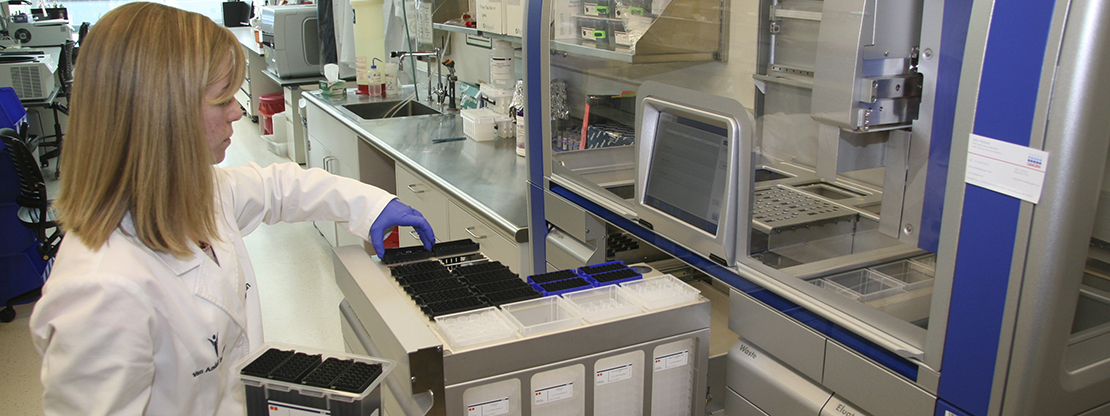Research brief: Harnessing a “genetic atlas” to investigate genesis of disease
October 23, 2017

The human body is a diverse landscape of cells and tissues, each with a specific job that makes everyday life possible.
But beneath the surface lies a mystery with far-reaching implications for understanding a host of diseases and finding better ways to treat them: if our 37.2 trillion cells each contain essentially the same genetic instructions, how do we end up with vastly different tissues types with an array of functions?
“What has become clear in recent years is that it’s not just our genes that make us who we are, it’s how the instructions in those genes are used or ignored,” said Dr. Scott Jewell, director of Van Andel Research Institute’s Core Technologies and Services team and its Biorepository. “Each genetic variation, even tiny ones, in some way impacts us physically, from informing eye color to how tall we are to our risk for certain diseases like cancer. Understanding how all of these components are linked is a powerful tool for improving human health.”
Now, thanks to the Genome Tissue Expression (GTEx) Consortium, scientists around the world have access to a detailed atlas that outlines the intricate and complicated connections between an individual’s genetic makeup—or genome—and gene expression, the way the instructions in our DNA are actually carried out. Findings from the consortium’s rigorous analysis were highlighted in a series of studies published Oct. 11 in Nature.
GTEx is a National Institutes of Health-funded initiative established in 2010 that harnessed the expertise of more than 80 organizations across the U.S. and abroad. VARI’s Biorepository played an integral role in sample collection, processing and storage for GTEx.
Connecting the dots
Determining which genetic variant matches up with a specific physical trait isn’t as simple as drawing a line from point A to point B on the genome, even within just one person. Often, regulatory regions are located far away from the gene they affect, making an already tangled web even messier.
The challenges only increase when the scope broadens to a population level study, which require a massive number of samples to account for differences between individuals.
To overcome this, GTEx established sample collection sites around the country to obtain normal tissues from a wide swath of the population. In total, more than 960 donors contributed samples from 53 different tissue types to the project through tissue transplant programs, autopsies and organ donations.
“GTEx depended entirely on families choosing to donate biosamples for research after the death of a loved one,” Susan Koester, Ph.D., deputy director for the Division of Neuroscience and Basic Behavioral Science and GTEx program director at the National Institute of Mental Health (NIMH), said in an announcement. “GTEx researchers are deeply grateful for this priceless gift.”
Setting the stage, delivering the promise
By rigorously analyzing these samples, GTEx investigators established a baseline for what normal, healthy tissue looks like on a molecular level and created a publicly available resource that will fuel scientific investigation for years to come. It will allow researchers to compare data from a disease sample, such as cancer, against this baseline and help them identify changes that may contribute to the onset and growth of the disease.
Another example can be found in the largest analysis of GTEx data to date, which comprised more than 7,000 samples from 449 donors and represented 44 tissue types. The results were among those published in Nature earlier this month.
The study for the first time outlines all known expression quantitative trait loci (eQTLs), small stretches of DNA that contribute to differences in gene expression. These tiny pieces of the genetic code are invaluable for helping scientists better understand how variations in the genome contribute to changes that give rise to diseases ranging from cancer to schizophrenia.
It’s safe to say that the ripple effect from GTEx will contribute to discoveries for years to come. Although the original GTEx has largely come to a close, a second project known as Enhancing GTEx has been underway since 2013. It pairs the project’s gene expression data with additional analysis to yield a more complete picture of the factors that influence the genome.
“GTEx not only created an incredible resource, but it proved that this type of multi-tissue, population-wide project can and should be done,” Jewell said. “I have no doubt that this wealth of data will continue to have a real-world impact on our understanding of health and disease, for the ultimate benefit of humanity.”
GTEx data is available through the GTEx Portal. Biospecimens from the project are available to qualified researchers; please visit the portal for more information. Research reported in this publication was supported by the National Institutes of Health under award number 10XS1035T8. The content is solely the responsibility of the authors and does not necessarily represent the official views of the National Institutes of Health.